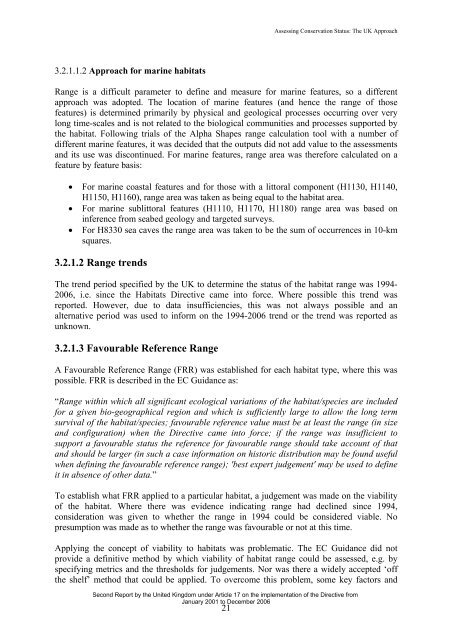Assessing Conservation Status: The UK Approach - JNCC
Assessing Conservation Status: The UK Approach - JNCC
Assessing Conservation Status: The UK Approach - JNCC
You also want an ePaper? Increase the reach of your titles
YUMPU automatically turns print PDFs into web optimized ePapers that Google loves.
<strong>Assessing</strong> <strong>Conservation</strong> <strong>Status</strong>: <strong>The</strong> <strong>UK</strong> <strong>Approach</strong><br />
3.2.1.1.2 <strong>Approach</strong> for marine habitats<br />
Range is a difficult parameter to define and measure for marine features, so a different<br />
approach was adopted. <strong>The</strong> location of marine features (and hence the range of those<br />
features) is determined primarily by physical and geological processes occurring over very<br />
long time-scales and is not related to the biological communities and processes supported by<br />
the habitat. Following trials of the Alpha Shapes range calculation tool with a number of<br />
different marine features, it was decided that the outputs did not add value to the assessments<br />
and its use was discontinued. For marine features, range area was therefore calculated on a<br />
feature by feature basis:<br />
• For marine coastal features and for those with a littoral component (H1130, H1140,<br />
H1150, H1160), range area was taken as being equal to the habitat area.<br />
• For marine sublittoral features (H1110, H1170, H1180) range area was based on<br />
inference from seabed geology and targeted surveys.<br />
• For H8330 sea caves the range area was taken to be the sum of occurrences in 10-km<br />
squares.<br />
3.2.1.2 Range trends<br />
<strong>The</strong> trend period specified by the <strong>UK</strong> to determine the status of the habitat range was 1994-<br />
2006, i.e. since the Habitats Directive came into force. Where possible this trend was<br />
reported. However, due to data insufficiencies, this was not always possible and an<br />
alternative period was used to inform on the 1994-2006 trend or the trend was reported as<br />
unknown.<br />
3.2.1.3 Favourable Reference Range<br />
A Favourable Reference Range (FRR) was established for each habitat type, where this was<br />
possible. FRR is described in the EC Guidance as:<br />
“Range within which all significant ecological variations of the habitat/species are included<br />
for a given bio-geographical region and which is sufficiently large to allow the long term<br />
survival of the habitat/species; favourable reference value must be at least the range (in size<br />
and configuration) when the Directive came into force; if the range was insufficient to<br />
support a favourable status the reference for favourable range should take account of that<br />
and should be larger (in such a case information on historic distribution may be found useful<br />
when defining the favourable reference range); 'best expert judgement' may be used to define<br />
it in absence of other data.”<br />
To establish what FRR applied to a particular habitat, a judgement was made on the viability<br />
of the habitat. Where there was evidence indicating range had declined since 1994,<br />
consideration was given to whether the range in 1994 could be considered viable. No<br />
presumption was made as to whether the range was favourable or not at this time.<br />
Applying the concept of viability to habitats was problematic. <strong>The</strong> EC Guidance did not<br />
provide a definitive method by which viability of habitat range could be assessed, e.g. by<br />
specifying metrics and the thresholds for judgements. Nor was there a widely accepted ‘off<br />
the shelf’ method that could be applied. To overcome this problem, some key factors and<br />
Second Report by the United Kingdom under Article 17 on the implementation of the Directive from<br />
January 2001 to December 2006<br />
21
















